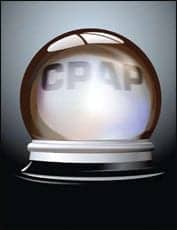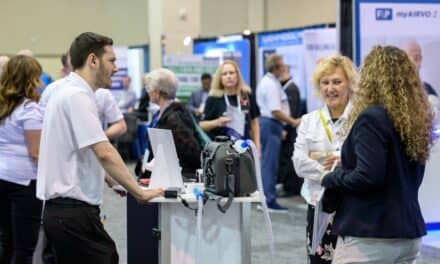A sleep specialist challenges industry norms by sharing case reports on his experiments with a CPAP mask algorithm adjustment.
By Alyx Arnett
Sleep specialist William H. Noah, MD, has been sharing some intriguing case study results on CPAP mask settings in his presentations at sleep conferences across the country.
The medical director of Sleep Centers of Middle Tennessee PLLC has been using the “full-face” CPAP mask setting for sleep apnea patients who are actually using nasal pillow masks. His theory is, because mask algorithms built into CPAP devices deploy more inspiratory pressure for nasal pillows masks (to compensate for the greater resistance of the small cushions), the nasal pillows mask setting inadvertently causes patient discomfort. He suspected the full-face mask setting would be more comfortable and so potentially increase the adherence of CPAP-naive patients. “The full-face setting has been unanimous so far,” Noah says. “We haven’t had anyone who thought the nasal pillow setting was more comfortable.”
According to a Philips Respironics spokesperson, Philips’ System One Resistance Control achieves complete system integration by enabling the device and mask to work optimally together. The technology—introduced in 2009 with Respironics’ launch of the System One sleep therapy system and included in the company’s DreamStation and DreamStation 2 platforms today—instructs the device to compensate for variable resistance characteristics related to different Philips Respironics masks. “With synchronous pressure delivery for every mask, patients can enjoy the full benefits of Flex comfort technologies no matter which mask is used,” the spokesperson states via email to Sleep Review.
According to a former CPAP manufacturer employee who helped develop mask compensation algorithms who requests anonymity, while a full-face mask doesn’t have much resistance, the nasal mask has some, and the nasal pillow mask has more; that resistance would adversely impact the pressure profile if an adjustment is not made to the pressure.
Noah’s opinion, however, is that pressure compensation algorithms made nasal pillow masks harder to wear due to increased inspiratory pressure and the accompanying increased air velocity in the nostrils. “All it did was decrease adherence for the nasal pillow mask,” he says.
So Noah began conducting an informal study among staff and patients at his sleep center. Participants tested a nasal pillow mask on the nasal pillow mask setting and the full-face mask setting. According to Noah, all participants reported the full-face setting was the most comfortable. Noah notes that participants were CPAP-naive and that long-time users may not prefer the full-face setting as they’ve gotten used to the higher pressure and flow. This is the data he is sharing at sleep conferences. He is currently also developing a formal trial, which is awaiting approval from the Institutional Review Board.
But wouldn’t using a different setting interfere with the efficacy of a patient’s sleep apnea therapy? Noah argues no. He is among a growing number of sleep medicine experts who believe the industry has gotten therapy backward.1 Noah, who is also CEO of SleepRes, which makes the V-Com CPAP accessory that lowers inspiratory pressure, has found evidence2 that expiratory pressure is actually key to successful therapy and should not be lessened, while inspiratory pressure “is not therapy” and can be lower for most patients. By putting a nasal pillow mask on a full face setting, the user prevents the further increase in inspiratory pressure that the device algorithm is doing (whereas the V-com causes a drop in the original inspiratory pressure and can optionally be used with the setting adjustment).
Noah’s preliminary experiments in this area are prompting other sleep specialists to rethink their CPAP setting prescriptions. Noah’s lecture on the topic last October at the Kentucky Sleep Society meeting was a turning point for Abinash Joshi, MD, sleep medical director at Owensboro Health.
“When we heard this, we were all just kind of looking around, like ‘that explains a lot in terms of what our patients experienced and why they’re experiencing it,’” says Abinash, who’s also president of the Kentucky Sleep Society. “So all of these algorithms for masks, like the nasal pillow compensation algorithm, that just causes more inspiratory pressure to go through those small holes in the nasal pillows and causes a jetting effect that’s just very harsh for patients, and they are becoming very intolerant. They take off the mask. They’re feeling like they’re suffocating or choking on the mask, and I often hear that in my practice.”
Abinash now has flipped to the full-face setting for his patients on nasal pillow masks, and he says they have felt more comfortable.
Recent experiences and collaboration with Noah have also prompted Robert Farney, MD, clinical professor of medicine in the Pulmonary Division/Sleep-Wake Center at the University of Utah College of Medicine, to modify his therapeutic strategies. Now he rarely enables expiratory pressure relief features and agrees that the automatic adjustment from the mask algorithms can result in “unnecessary” increased inspiratory pressure when programmed on the nasal pillow setting.
“Based on my frequent interactions with other sleep medicine specialists, very few, if any, are aware of these important aspects of PAP therapy. Most wrongly assume that the masks are interchangeable, just like most wrongly assume problems with residual respiratory events can be corrected with higher IPAP [inspiratory positive airway pressure] pressure settings or more pressure support,” says Farney. “And I doubt that any but a select few are aware of the undesired effects of programming the CPAP device for nasal pillows.”
Noah says he remembers prescribing “a ton” of nasal pillow masks to patients in the early 2000s before the mask compensation algorithms were designed. He says the mask style effectively opened the nasal airways for his patients and that his patients were likelier to wear it versus a full-face mask. He thinks the nasal pillow mask fell out of favor for some of his patients when the mask compensation algorithms were released. “We’ve just seen, since that time, we’ve got less adherence. We’ve got less people able to tolerate nasal pillow, and our full-face mask use increased,” Noah says.
Noah stresses the importance of mask selection and the role of the sleep specialist in that decision. He says he and many of his peers traditionally have left the mask decision to the respiratory therapists and the patients, not realizing how much science was in it.
“I was the biggest offender,” Noah says. “A new mask came out, and I’d say [to the manufacturer], ‘Show it to my respiratory therapists.’ Because they’re the ones who just make those decisions, right? I didn’t get involved. But now I’ve gotten really involved. So now we don’t even let the patient choose the type of mask. We choose for them, just like medicine.”
Noah says around 95% of patients at his sleep centers now receive a nasal pillow mask.
The American Thoracic Society also emphasized the importance of mask selection in a study that noted an “overuse of oronasal [full face] masks as the initial mask choice.” Researchers found higher patient satisfaction and treatment outcomes with nasal masks versus oronasal masks. They discovered that when pressure or adherence was similar in nasal and oronasal masks, satisfaction was higher with nasal interfaces.3
According to Robert Miller, RPSGT, vice president of sleep business at Apria Healthcare, Noah’s research underscores the importance of scrutinizing mask compensation algorithm accuracy, the efficacy of current therapy, and the potential for creating more patient-friendly alternatives.
“[Noah] has a point that the industry needs to really stand up and take notice … Ultimately, we’re all trying to get to better outcomes for patients and higher patient acceptance and adherence,” says Miller.
In the long term, Noah believes the industry should reexamine how CPAP machines are designed and how therapy is delivered. But for now, the flip of a setting is helping more of his patients ease into CPAP usage.
References
- Brusie C. A potentially huge CPAP pressure mistake. 16 Nov 2022. Sleep Review. Available at sleepreviewmag.com/sleep-treatments/therapy-devices/cpap-pap-devices/cpap-pressure-mistake.
- Gugger M, Vock P. Effect of reduced expiratory pressure on pharyngeal size during nasal positive airway pressure in patients with sleep apnoea: evaluation by continuous computed tomography. Thorax. 1992 Oct;47(10):809-13.
- Genta PR, Kaminska M, Edwards BA, et al. The importance of mask selection on continuous positive airway pressure outcomes for obstructive sleep apnea. An official American Thoracic Society workshop report. Ann Am Thorac Soc. 2020;17(10):1177-85.
Photo caption: William Noah
Photo credit: William Noah




